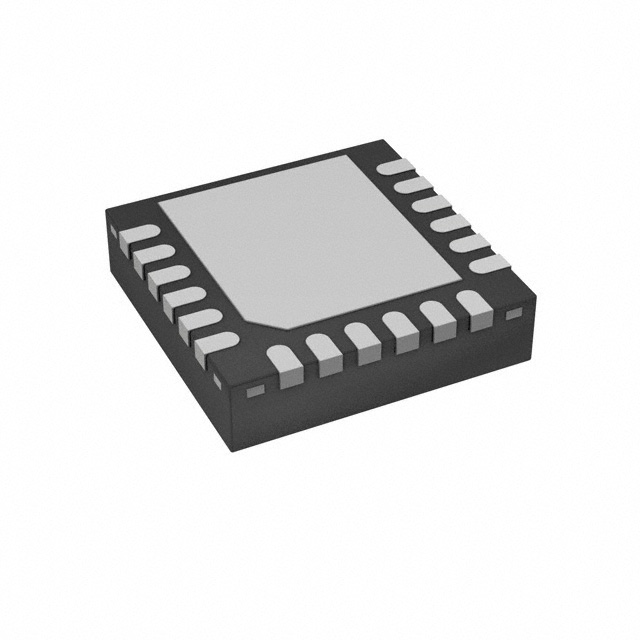ATA6831-PIPW
Product Overview
Category
ATA6831-PIPW belongs to the category of integrated circuits (ICs).
Use
ATA6831-PIPW is primarily used for motor control applications in automotive systems.
Characteristics
- Integrated circuit designed for motor control
- Specifically developed for automotive applications
- High reliability and robustness
- Compact package size
- Low power consumption
Package
ATA6831-PIPW is available in a small outline package (SOP) with a specified pin configuration.
Essence
The essence of ATA6831-PIPW lies in its ability to provide efficient and reliable motor control in automotive systems, ensuring optimal performance and safety.
Packaging/Quantity
ATA6831-PIPW is typically packaged in reels or tubes, with a quantity of 2500 units per reel/tube.
Specifications
- Operating voltage: 5V to 18V
- Maximum output current: 1.5A
- Number of channels: 3
- Communication interface: SPI (Serial Peripheral Interface)
- Operating temperature range: -40°C to +125°C
Detailed Pin Configuration
ATA6831-PIPW features the following pin configuration:
- VCC: Power supply input
- GND: Ground connection
- MISO: Master In Slave Out (SPI communication)
- MOSI: Master Out Slave In (SPI communication)
- SCK: Serial Clock (SPI communication)
- CS: Chip Select (SPI communication)
- OUT1: Motor output channel 1
- OUT2: Motor output channel 2
- OUT3: Motor output channel 3
- DIAG: Diagnostic output
- EN: Enable pin
- REF: Reference voltage input
Functional Features
- Motor control: ATA6831-PIPW provides precise control over motor speed and direction.
- Diagnostic capabilities: The DIAG pin allows monitoring of motor status and fault detection.
- SPI communication: The integrated SPI interface enables easy integration with microcontrollers or other devices.
- Overcurrent protection: ATA6831-PIPW incorporates overcurrent protection to prevent damage to the motor or the IC itself.
- Thermal shutdown: In case of excessive temperature, the IC automatically shuts down to avoid overheating.
Advantages and Disadvantages
Advantages
- High reliability and robustness make it suitable for automotive applications.
- Compact package size allows for space-efficient designs.
- Low power consumption contributes to energy efficiency.
- Diagnostic capabilities enhance system monitoring and troubleshooting.
Disadvantages
- Limited output current may restrict its use in high-power motor applications.
- Requires external microcontroller or device for complete functionality.
Working Principles
ATA6831-PIPW operates by receiving control signals from an external microcontroller through the SPI interface. These signals determine the desired motor speed and direction. The IC then processes these signals and generates appropriate output voltages to drive the motor. Diagnostic information is also provided through the DIAG pin, allowing for real-time monitoring of motor status.
Detailed Application Field Plans
ATA6831-PIPW finds extensive application in various automotive systems, including:
- Electric power steering (EPS) systems
- Electric braking systems
- HVAC (Heating, Ventilation, and Air Conditioning) blowers
- Window lift mechanisms
- Seat adjustment systems
Detailed and Complete Alternative Models
- ATA6830-PIPW: Similar to ATA6831-PIPW but with two motor output channels instead of three.
- ATA6832-PIPW: Similar to ATA6831-PIPW but with additional features such as integrated current sensing.
In conclusion, ATA6831-PIPW is a reliable and efficient integrated circuit designed for motor control in automotive applications. Its compact size, low power consumption, and diagnostic capabilities make it a suitable choice for various motor-driven systems in vehicles.
Word count: 514
Senaraikan 10 soalan dan jawapan biasa yang berkaitan dengan aplikasi ATA6831-PIPW dalam penyelesaian teknikal
Sure! Here are 10 common questions and answers related to the application of ATA6831-PIPW in technical solutions:
Q1: What is ATA6831-PIPW? A1: ATA6831-PIPW is a highly integrated system basis chip (SBC) designed for automotive applications, providing various functions such as power management, communication interfaces, and diagnostics.
Q2: What are the key features of ATA6831-PIPW? A2: The key features of ATA6831-PIPW include LIN transceiver, voltage regulator, watchdog timer, low-drop voltage regulator, and various diagnostic features.
Q3: How can ATA6831-PIPW be used in technical solutions? A3: ATA6831-PIPW can be used as a central component in automotive electronic systems, enabling communication between different modules and providing power management capabilities.
Q4: What is the purpose of the LIN transceiver in ATA6831-PIPW? A4: The LIN transceiver in ATA6831-PIPW allows for communication over the Local Interconnect Network (LIN) protocol, which is commonly used in automotive applications for low-speed data exchange.
Q5: Can ATA6831-PIPW be used in non-automotive applications? A5: While ATA6831-PIPW is primarily designed for automotive applications, it can also be used in other industrial or embedded systems that require similar functionalities.
Q6: What are the advantages of using ATA6831-PIPW in technical solutions? A6: Some advantages of using ATA6831-PIPW include reduced development time, simplified system design, improved reliability, and enhanced diagnostics capabilities.
Q7: Is ATA6831-PIPW compatible with other communication protocols? A7: ATA6831-PIPW is primarily designed for LIN communication, but it can also be used in combination with other communication protocols such as CAN (Controller Area Network) or FlexRay.
Q8: Can ATA6831-PIPW handle multiple voltage levels? A8: Yes, ATA6831-PIPW includes a voltage regulator that can handle multiple voltage levels, providing power supply to different components within the system.
Q9: What diagnostic features are available in ATA6831-PIPW? A9: ATA6831-PIPW offers various diagnostic features such as overvoltage and undervoltage detection, temperature monitoring, and fault reporting, which help in identifying and troubleshooting issues.
Q10: Are there any development tools or resources available for ATA6831-PIPW? A10: Yes, Atmel provides development tools, documentation, and support for ATA6831-PIPW, including evaluation boards, software libraries, and application notes to assist in the design and implementation process.
Please note that these questions and answers are general and may vary depending on specific technical requirements and applications.


